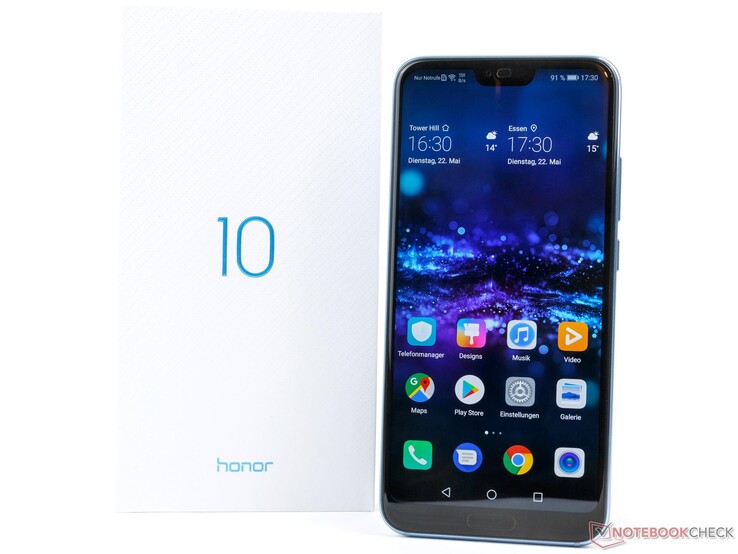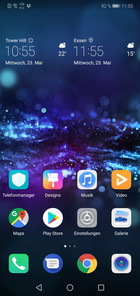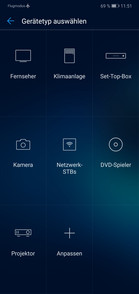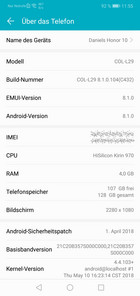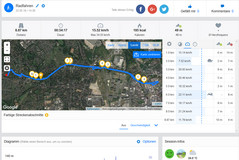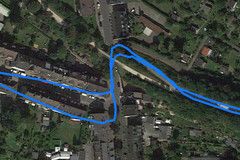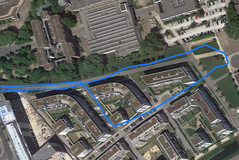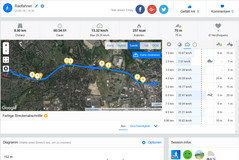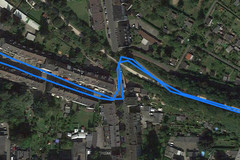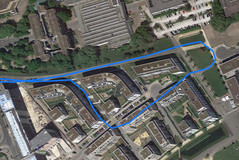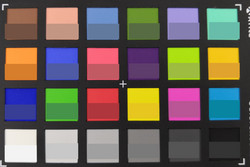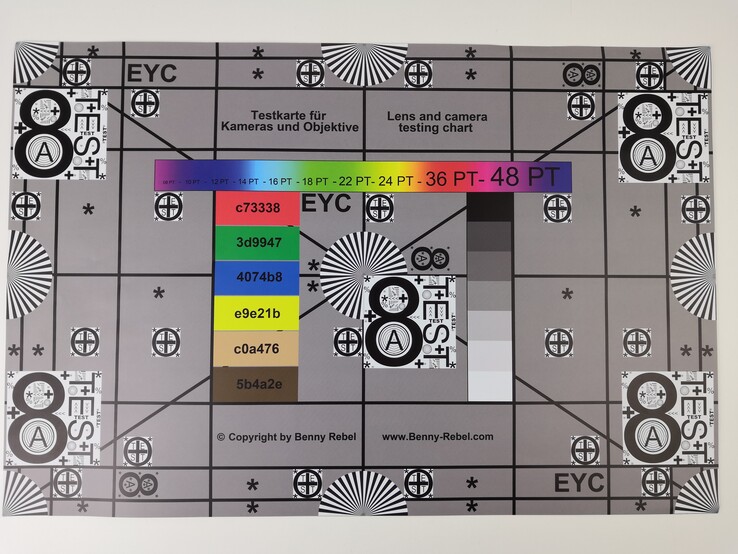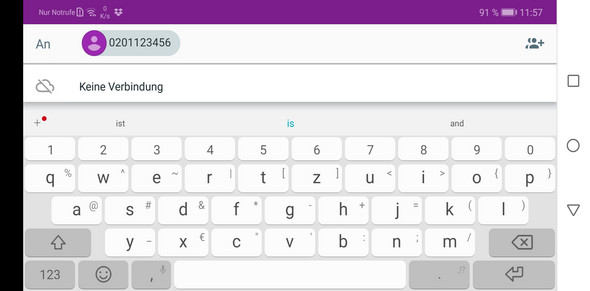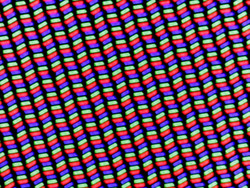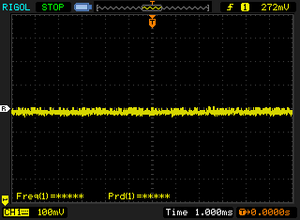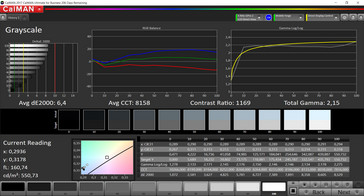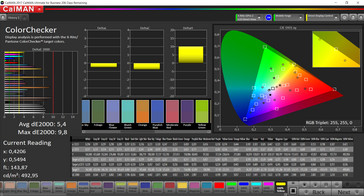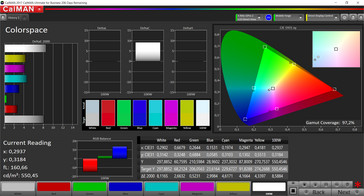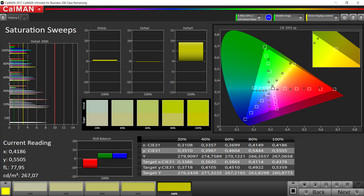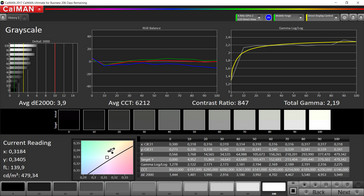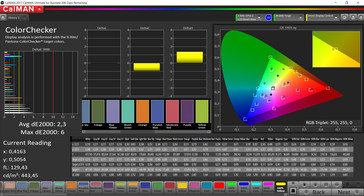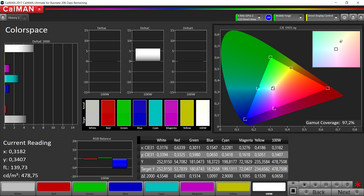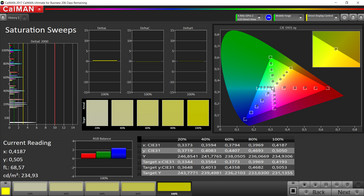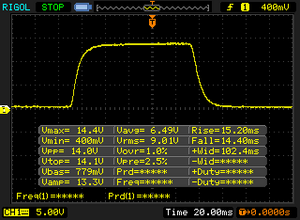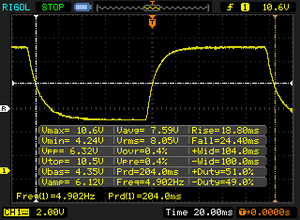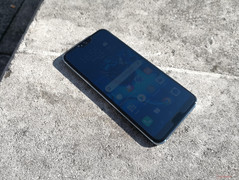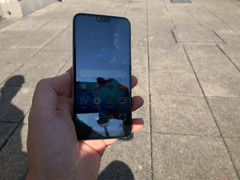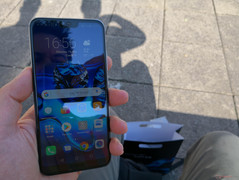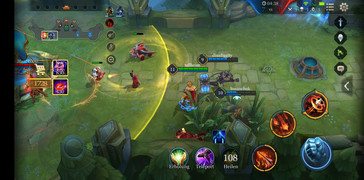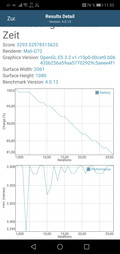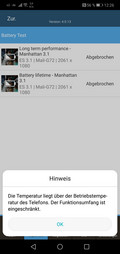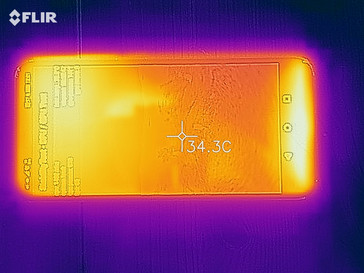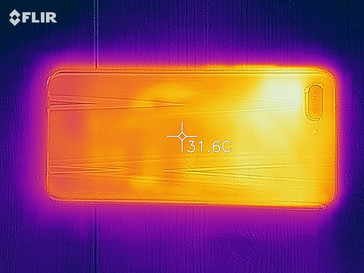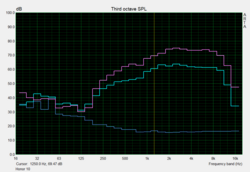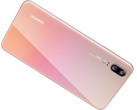Honor 10 Smartphone Review
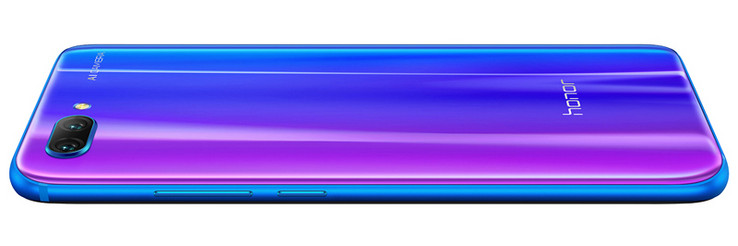
With the Honor 10, the Chinese manufacturer presents its flagship smartphone for this year. While it cannot deny its relationship to the Huawei P20 in terms of its data sheet, Honor is trying to differentiate itself visually from the parent company by using glass and unusual color options. The Honor 10 is driven by a Kirin 970 and offers 4 GB of working memory. The internal storage can be either 64 or 128 GB, but in contrast to the Chinese version, the larger model does not have more RAM. Unfortunately, the manufacturer has removed the option to expand the storage from its smartphone. The dual camera was improved and is now supported by AI algorithms and the NPU. In terms of its price, Honor had a surprise for us. While the Honor 9 did still cost 479 Euros (~$562), defeating the market trend, the price for the smaller storage model drops to 399 Euros (~$468) and that of the larger model to 449 Euros (~$527).
With this, the Honor 10 is considerably more affordable than the rest of all the flagship smartphones and even creates a price distance from the OnePlus 6, coming closer to the prices of the BQ Aquaris X Pro or Nokia 7 Plus. Other competitors in this price range include the Samsung Galaxy A8 (2018) or even older top smartphones such as the Sony Xperia XZ1. Due to its similar equipment, we are also adding the Huawei P20 to our comparison, even though it is more expensive at 649 Euros, and also the Huawei P20 Lite whose price of 369 Euros (~$433) is quite close to the Honor 10, and it also has the same display specifications.
We would like to give you a first impression with this live test and will then expand the test little by little.
Changelog:
- May 17, 2018: Added sections on Display and Gaming and expanded Performance section.
- May 18, 2018: Added sections on Power, Speakers, and Temperatures.
- May 21, 2018: Added Battery Life section.
- May 23, 2018: Added Software, Communication, GPS, and Input Device sections and completed Camera section.
- May 23, 2018: Review completed.
- July 05, 2018: a new firmware with various improvements released. Please see the software section for more details.
- August 28, 2018: an update was released. See Software section for more details.
Case - Glass dominates the smartphone
Compared to its predecessor, the Honor 10 is slightly larger in all dimensions, which can primarily be traced back to the larger display. For the first time, a smartphone of this series has a camera bulge which is raised by 1 mm on the back. Furthermore, the glass back is less rounded on the sides than was still the case with the Honor 9.
The workmanship is at a good level, and the gaps are tight and close-fitting. While the Honor smartphone does not react to attempts at twisting it, the back of it can be pressed down relatively far. However, you have to press pretty hard, if you want to see waves forming on the LCD display. The card slot can accept two Nano-SIM cards and is now made from aluminum. There is no particular protection against dust or water.
The Honor 10 is offered in the colors Black, Gray, Phantom Green, and Phantom Blue. Having a slight blue luster, the gray differs from that of the Honor 9. The "Phantom" tones change their colors, depending on the viewing angle. While the green model reminds of the northern lights, the colors in the blue model change from blue to violet. These color effects are accomplished by the so-called "Aurora glass," which is a glass surface having 15 layers, enabling it to reflect the natural light in 36 colors of the spectrum.
Equipment - Honor bans the microSD
There are no real improvements compared to the predecessor of the Honor 10. Bluetooth still runs at version 4.2, and there is an NFC chip. While the USB connection is the the newer Type-C, it still uses the 2.0 transfer standard and does not support image or sound output. However, it does support OTG, so that you can connect external peripherals and storage media to the smartphone.
There is also an infrared transmitter on board again with which you can control cameras, a TV, and so forth. But you cannot expand the storage via microSD card anymore.
Software - The Honor 10 uses the current Android
At the time of the test, the operating system of the Honor 10 is the most current Google Android 8.1 Oreo. On top of that, Huawei has layered its own EMUI 8.1, which we already know from the Huawei P20 among others.
In addition to the Google apps, other apps and games are already preinstalled, including Instagram and Facebook among others. Anyone who does not need these apps can just uninstall or deactivate them. There is also a Honor app which simply links to the website to the manufacturer.
The user account management that is activated in the Honor 10 is very practical. The Google security patches are on the level of April 1, 2018 and thus current.
Update 07/05/2018: Honor has released a new firmware, version COL-L29 8.1.0.120 (882 MB). It includes a party mode app that is capable of synchronizing music playback over multiple smartphones. It also improved the fingerprint reader algorithms and can now determine a fingerprint’s quality and give tips for improving detectability. The camera app’s AI display has been improved, and the front-facing camera’s color accuracy is supposed to be more natural now. Two more designs have been added in addition to the existing ones that have been further optimized. Power consumption is supposed to have been improved, and last but not least Google security patches have been updated and are now as of 5/5/2018.
Update 08/28/2018: Honor released Firmware COL-L29 8.1.0.143 (1.16 GB), which activates the GPU Turbo (here in review) and optimizes the camera. The latter can now capture hand guided night shots, but Honor also added more picture effects and a super slow-motion at 480 FPS. The security patches are updated to July 1st, 2018.
Communication and GPS - Good locating, but few LTE bands
The Honor supports the IEEE-802.11 a/b/g/n/ac WLAN standards and correspondingly uses the 2.4 and 5.0 GHz frequencies. The transfer speeds to our Linksys EA8500 reference router are decent, but we would have preferred them to be slightly higher. However, the range is good and gives no reason for complaint.
The modem of the Kirin 970 nominally supports LTE Cat. 18 and with that download speeds up to 1.2 GBit/s. Unfortunately, the selection of supported frequency bands is not as high as in the OnePlus 6 or the P20, which causes us to assume that the transfer speeds also turn out slightly lower. Currently there is no concrete information on that from the manufacturer. We will add this as soon as it becomes available. While there should not be any problems inside Europe, USA travelers will have to make do without LTE. The reception characteristics of the smartphone were inconspicuous.
| Networking | |
| iperf3 transmit AX12 | |
| Huawei P20 | |
| Asus ZenFone 4 ZE554KL | |
| Nokia 7 Plus | |
| Samsung Galaxy A8 2018 | |
| Honor 10 | |
| Honor 9 | |
| Motorola Moto G6 | |
| iperf3 receive AX12 | |
| Huawei P20 | |
| Asus ZenFone 4 ZE554KL | |
| Honor 9 | |
| Samsung Galaxy A8 2018 | |
| Nokia 7 Plus | |
| Honor 10 | |
| Motorola Moto G6 | |
The Honor 10 supports the GPS, Glonass, and BeiDou satellite networks. Outdoors, the locating is extremely fast and also accurate at 5 meters (~16.4 ft). Indoors, it takes a few seconds longer, and the accuracy varies strongly, at times being even more than 500 meters (~0.3 miles).
We take the Honor smartphone on a bike ride in order to test how it does in everyday life, comparing it with the Garmin Edge 500 bicycle computer. The Honor 10 succeeds very well and often draws an even slightly more accurate route than the navigation specialist.
Telephone Functions and Voice Quality
The Telephone app of the Honor 10 is structured clearly, and anyone should be able find their way around quickly. The two microphones of the smartphone do a decent job and ensure a good communication.
However, as we already saw in the Honor 9, the earpiece tends towards slight distortions at higher volumes, and our voice also sounds slightly hollow on the phone. The speaker is acceptable, but has a noticeable echo.
The Honor smartphone supports VoLTE as well as WLAN calling.
Cameras – The dual camera is strong, but not the top
At 24 MP, the front camera of the Honor 10 has a very high resolution. It uses light fusion technology, which combines the information from four pixels into one. An aperture of f/2.0 suggests a decent light sensitivity. In addition to a ten-step Beauty mode, there is also a Portrait mode as we know it from the iPhone X or the P20 Pro. This allows you to immerse the motif in various shades of light, and a spot light can change the light incidence after the fact. Selfies succeed well in daylight, and while the quality drops noticeably in darker surroundings, you can still take acceptable photos. Furthermore, the display can be used as illumination if it is too dark. With the front camera, videos can only be recorded in the low HD resolution (720p). We did not notice an image stabilizer.
The dual camera on the back offers a color and a monochrome sensor, which have a resolution of 24 and 16 MP respectively. Both have an f/1.8 aperture. While there is no optical image stabilizer, there should be an electronic version. However, until now we could not find this anywhere in the camera settings. The Honor 10 offers numerous functions and now also the support of AI. While this is not activated automatically, it visibly improves the pictures and can also be removed later. With the AI function activated, primarily the dynamic range and the richness of detail are improving. On the other hand, it tends to saturate the colors a little to much. Particularly green color can really jump into your notice, so to speak.
The quality of the recordings is very good and convincing. The pictures are comfortably sharp and numerous details are captured. In images recorded during daylight, you can only see a difference to the more expensive competition at full magnification. While the Honor 10 still produces good images in weak surrounding light or taking pictures against the light, in these cases you can clearly see the difference to top-models such as the Galaxy S9+ or the P20 Pro.
The hybrid zoom is also on board again. This digital zoom allows you to take images at 2x magnification with hardly any loss.
In our example photos, you can also find faulty images. In image 1, the fault shows in the blue of the sky. Since this did not occur in the rest of the images, we assume that the lens was simply not quite clean. However, this could not have been the case in image 2, which traces the shape of an adjacent building with a glow. In this case, taking the picture against the light might have given the software some trouble. However, since we were unable to reproduce this fault as well, it might have been more of a singular occurrence rather than a general problem.
You can record videos in Ultra HD (2160 @ 30 fps) at most. While these should also be protected from blurriness with an electronic image stabilizer, we cannot find anything on that in the settings. The object tracking is only available at Full HD (1080p @ 30 fps) or lower.
We perform further tests of the Honor 10 camera under controlled light conditions. When we evaluate the color reproduction of the camera with the ColorChecker Passport, we notice that the colors are brightened quite a lot and particularly blue and green are oversaturated. The white balance is fairly good and only slightly too warm.
The reproduction of the test chart succeeds fairly well with the Honor 10. While the color graduations are reproduced cleanly, the writing on dark background is visibly frayed. The image sharpness in the center is also satisfactory and only decreases minimally towards the edges.
Accessories and Warranty
Included with the Honor 10 are a Gel cover, a modular charger, a USB cable (Type-A to Type-C), a SIM tool, a screen protector as well as a quick-start leaflet, warranty conditions, and a security guide.
The warranty is 24 months. Some vendors such as Otto are offering an increase of the warranty period to three years at the market introduction. Please see our Guarantees, Return policies and Warranties FAQ for country-specific information.
Input Devices and Navigation
The capactive touchscreen of the Honor 10 has good sliding characteristics and recognizes up to ten simultaneous touch points. Inputs are recognized quickly and implemented accurately on the screen. In single-handed operation, the screen can be decreased using a swiping gesture, so that you can also comfortably type messages with only one hand, if necessary.
Honor uses the SwiftKey keyboard layout. Those who do not like this can download and install another keyboard from the Play Store without any trouble.
In addition to the usual methods for unlocking the device such as a pattern, PIN, or password, you also have the option to use face recognition or the fingerprint sensor. The latter is located in front below the glass. The recognition rates are good and the unlocking is sufficiently fast, although it was even faster in the Honor 9. Using gestures, the sensor can also replace the onscreen keys of the operating system. While this works fairly well, we noticed that not all of the games would recognize the Back function as such. The face recognition is faster for the unlocking, but was not quite as reliable. Sometimes it refused to work, particularly in low light.
Display - A good IPS panel
Compared to the Honor 9 (5.15 in, 73.12 cm²), the display of the Honor 10 was increased to 5.84 in (14.83 cm, 85.13 cm²) and now has a 19:9 format. The bezels are pleasantly narrow, and there is a notch, although you can remove this via software in the settings.
Nominally, the IPS panel of the Honor 10 has the same specifications as the Huawei P20 Lite. However, Honor has fine-tuned this a little more and primarily offers a better black value, but also a bit more brightness, which is also better distributed. Overall, the brightness is on a quite good level at 537 cd/m² on average. During a measurement with evenly distributed dark and bright areas, the values turn out slightly lower (center: 538 cd/m² maximum, black value: 0.42 cd/m², contrast: 1281:1).
A low minimum brightness, a blue-light filter, and the lack of pulsewidth modulation will primarily please the fans of ebooks, since the eyes are stressed relatively less in the dark. We did not notice any annoying light halos in our Honor smartphone.
| |||||||||||||||||||||||||
Brightness Distribution: 94 %
Center on Battery: 555 cd/m²
Contrast: 1423:1 (Black: 0.39 cd/m²)
ΔE ColorChecker Calman: 2.3 | ∀{0.5-29.43 Ø4.77}
ΔE Greyscale Calman: 3.9 | ∀{0.09-98 Ø5}
97.2% sRGB (Calman 2D)
Gamma: 2.19
CCT: 6212 K
| Honor 10 IPS, 2280x1080, 5.8" | Honor 9 IPS/LTPS, 1920x1080, 5.2" | Huawei P20 Lite IPS, 2280x1080, 5.8" | Huawei P20 LTPS, 2240x1080, 5.8" | Samsung Galaxy A8 2018 Super AMOLED, 2220x1080, 5.6" | Nokia 7 Plus IPS, 2160x1080, 6" | Asus ZenFone 4 ZE554KL IPS, 1920x1080, 5.5" | |
|---|---|---|---|---|---|---|---|
| Screen | -4% | -36% | 36% | -24% | -8% | -18% | |
| Brightness middle (cd/m²) | 555 | 550 -1% | 528 -5% | 753 36% | 541 -3% | 458 -17% | 656 18% |
| Brightness (cd/m²) | 537 | 535 0% | 525 -2% | 748 39% | 538 0% | 463 -14% | 634 18% |
| Brightness Distribution (%) | 94 | 92 -2% | 89 -5% | 96 2% | 96 2% | 92 -2% | 93 -1% |
| Black Level * (cd/m²) | 0.39 | 0.42 -8% | 0.51 -31% | 0.37 5% | 0.22 44% | 0.4 -3% | |
| Contrast (:1) | 1423 | 1310 -8% | 1035 -27% | 2035 43% | 2082 46% | 1640 15% | |
| Colorchecker dE 2000 * | 2.3 | 3.3 -43% | 4.7 -104% | 1.3 43% | 5.8 -152% | 4 -74% | 5.3 -130% |
| Colorchecker dE 2000 max. * | 6 | 4.5 25% | 8.9 -48% | 2.3 62% | 7.4 -23% | 7.8 -30% | |
| Greyscale dE 2000 * | 3.9 | 3.6 8% | 6.4 -64% | 1.7 56% | 2.7 31% | 4.7 -21% | 5.2 -33% |
| Gamma | 2.19 100% | 2.38 92% | 2.22 99% | 2.18 101% | 2.07 106% | 2.19 100% | 2.22 99% |
| CCT | 6212 105% | 7226 90% | 7987 81% | 66.76 9736% | 6570 99% | 7425 88% | 7905 82% |
* ... smaller is better
Screen Flickering / PWM (Pulse-Width Modulation)
| Screen flickering / PWM not detected | |||
In comparison: 53 % of all tested devices do not use PWM to dim the display. If PWM was detected, an average of 8084 (minimum: 5 - maximum: 343500) Hz was measured. | |||
We evaluate the color accuracy of the display using a photo spectrometer and the CalMAN analysis software. In the standard settings, the display colors are slightly too cool. For the trained eye, the deviations are primarily visible in light gray and white tones, but they are not disturbing. Things look similar in the colors, and the skin tones in particular deviate relatively far from the target. We achieve the most natural reproduction, if we select the Standard color profile together with a cool white balance. Although then the display is still slightly too warm, it is very pleasing and you can hardly see the color deviations with your bare eyes anymore. Only cyan is displayed slightly too greenish. Those deciding for the optimal color reproduction will have to be content with the smaller sRGB color space. In summary, the Honor 10 also delivers a good performance in this area and is superior to the competitors in this price range. Even in the high-end segment, there are some devices that cannot achieve such an accurate reproduction.
Display Response Times
| ↔ Response Time Black to White | ||
|---|---|---|
| 29.6 ms ... rise ↗ and fall ↘ combined | ↗ 15.2 ms rise | |
| ↘ 14.4 ms fall | ||
| The screen shows relatively slow response rates in our tests and may be too slow for gamers. In comparison, all tested devices range from 0.1 (minimum) to 240 (maximum) ms. » 78 % of all devices are better. This means that the measured response time is worse than the average of all tested devices (20.2 ms). | ||
| ↔ Response Time 50% Grey to 80% Grey | ||
| 43.2 ms ... rise ↗ and fall ↘ combined | ↗ 18.8 ms rise | |
| ↘ 24.4 ms fall | ||
| The screen shows slow response rates in our tests and will be unsatisfactory for gamers. In comparison, all tested devices range from 0.165 (minimum) to 636 (maximum) ms. » 71 % of all devices are better. This means that the measured response time is worse than the average of all tested devices (31.6 ms). | ||
The viewing angle stability of the Honor 10 ranges on the expected level for an IPS panel. The viewing angles are very stable and there are no color inversions at any time. From very steep viewing angles diagonally across the display, the display appears warmer and the brightness slightly reduced. While we can also see an IPS glow effect in dark environments, this is not impacting everyday usage.
Performance – The Kirin 970 ensures a strong performance
The HiSilicon Kirin 970 ensures the necessary computing power in the Honor 10. We are already familiar with it from some Huawei smartphones such as the Mate 10 Pro and the P20. The chip is produced in the modern 10-nm processes and uses the big.LITTLE principle. There are two clusters with four cores each. The performance cluster runs with Cortex-A73 cores which have a clock speed of up to 2.4 GHz. The A53 cores take on lighter computing tasks and reach up to 1.8 GHz. As graphics unit, an ARM Mali-G72 MP12 is used, and the system offers 4 GB of working memory.
The benchmarks are on the expected level, and the Honor 10 does not allow itself any real outliers. The system performance of the current Android 8.1 Oreo in particular knows how to please. This subjective impression is confirmed by the system benchmarks such as AnTuTu or PCMark. The competition of the 400-Euro (~$470) devices in general has a hard time to keep up with the speed of the Honor 10, and even the Xperia XZ1, which also has a high-end SoC, is slower in parts.
| AnTuTu v6 - Total Score (sort by value) | |
| Honor 10 | |
| Samsung Galaxy A8 2018 | |
| Nokia 7 Plus | |
| Asus ZenFone 4 ZE554KL | |
| Sony Xperia XZ1 | |
| Huawei P20 | |
| Motorola Moto G6 | |
| Average HiSilicon Kirin 970 (173653 - 181973, n=8) | |
| AnTuTu v7 - Total Score (sort by value) | |
| Honor 10 | |
| Samsung Galaxy A8 2018 | |
| Nokia 7 Plus | |
| Asus ZenFone 4 ZE554KL | |
| Huawei P20 | |
| Motorola Moto G6 | |
| Average HiSilicon Kirin 970 (152773 - 212278, n=6) | |
| Lightmark - 1920x1080 1080p (sort by value) | |
| Samsung Galaxy A8 2018 | |
| Nokia 7 Plus | |
| Asus ZenFone 4 ZE554KL | |
| Motorola Moto G6 | |
| Average HiSilicon Kirin 970 (21.5 - 25.9, n=2) | |
| Basemark ES 3.1 / Metal - offscreen Overall Score (sort by value) | |
| Samsung Galaxy A8 2018 | |
| Nokia 7 Plus | |
| Asus ZenFone 4 ZE554KL | |
| Motorola Moto G6 | |
| Average HiSilicon Kirin 970 (788 - 887, n=2) | |
| Average of class Smartphone (205 - 7731, n=34, last 2 years) | |
We analyze the browser performance of the Honor 10 using the preinstalled Google Chrome 66. The smartphone leaves a very good impression in the benchmarks and can always be found in the top third of the comparison field. Subjectively, the pages are also loaded quickly and rendered cleanly.
| JetStream 1.1 - Total Score | |
| Sony Xperia XZ1 (Chrome 61) | |
| Honor 9 (Chrome 59) | |
| Honor 10 (Chrome 66) | |
| Huawei P20 (Chrome 66.0.3359.126) | |
| Nokia 7 Plus (Chrome 60) | |
| Average HiSilicon Kirin 970 (33.1 - 58.6, n=8) | |
| Samsung Galaxy A8 2018 (Chrome 64.0.3282.137) | |
| Asus ZenFone 4 ZE554KL (Chrome 62) | |
| Huawei P20 Lite (Chrome 63) | |
| Motorola Moto G6 (Chrome 66) | |
| Octane V2 - Total Score | |
| Average of class Smartphone (2228 - 126661, n=194, last 2 years) | |
| Huawei P20 (Chrome 66.0.3359.126) | |
| Honor 10 (Chrome 66) | |
| Nokia 7 Plus (Chrome 60) | |
| Honor 9 (Chrome 59) | |
| Average HiSilicon Kirin 970 (6692 - 11838, n=8) | |
| Sony Xperia XZ1 (Chrome 61) | |
| Samsung Galaxy A8 2018 (Chrome 64.0.3282.137) | |
| Asus ZenFone 4 ZE554KL (Chrome 62) | |
| Huawei P20 Lite | |
| Motorola Moto G6 (Chrome 66) | |
| Mozilla Kraken 1.1 - Total | |
| Motorola Moto G6 (Chrome 66) | |
| Huawei P20 Lite (Chrome 63) | |
| Asus ZenFone 4 ZE554KL (Chrome 62) | |
| Average HiSilicon Kirin 970 (3591 - 6221, n=8) | |
| Samsung Galaxy A8 2018 (Chrome 64.0.3282.137) | |
| Huawei P20 (Chrome 66.0.3359.126) | |
| Nokia 7 Plus (Chrome 60) | |
| Honor 10 (Chrome 66) | |
| Sony Xperia XZ1 (Chrome 61) | |
| Honor 9 (Chrome 59) | |
| Average of class Smartphone (257 - 28190, n=154, last 2 years) | |
| WebXPRT 2015 - Overall | |
| Huawei P20 (Chrome 66.0.3359.126) | |
| Honor 10 (Chrome 66) | |
| Sony Xperia XZ1 (Chrome 61) | |
| Nokia 7 Plus (Chrome 60) | |
| Average HiSilicon Kirin 970 (119 - 187, n=8) | |
| Samsung Galaxy A8 2018 (Chrome 64.0.3282.137) | |
| Honor 9 (Chrome 59) | |
| Asus ZenFone 4 ZE554KL (Chrome 62) | |
| Motorola Moto G6 (Chrome 66) | |
| Huawei P20 Lite (Chrome 63) | |
| WebXPRT 3 - Overall | |
| Average of class Smartphone (38 - 380, n=30, last 2 years) | |
| Huawei P20 | |
| Honor 10 (Chrome 66) | |
| Average HiSilicon Kirin 970 (69 - 69, n=3) | |
| Nokia 7 Plus (Chrome 60) | |
| Huawei P20 Lite (Chrome 63) | |
| Motorola Moto G6 (Chrome 66) | |
* ... smaller is better
The Honor 10 is delivered with 64 of the 128 GB in Germany, and in China a 256 GB version is also available. Our test unit is equipped with an ample 128 GB of UFS-2.1 storage, which can convince with a fast performance in all areas. At this point, such a fast storage module is unique in this price range.
Unfortunately you cannot expand the storage via microSD card anymore.
| Honor 10 | Honor 9 | Samsung Galaxy A8 2018 | Nokia 7 Plus | Asus ZenFone 4 ZE554KL | Sony Xperia XZ1 | Average 128 GB UFS 2.1 Flash | Average of class Smartphone | |
|---|---|---|---|---|---|---|---|---|
| AndroBench 3-5 | -50% | -61% | -52% | -52% | -24% | 8% | 315% | |
| Sequential Read 256KB (MB/s) | 828 | 293 -65% | 299.9 -64% | 283.1 -66% | 287.4 -65% | 679 -18% | 761 ? -8% | 2235 ? 170% |
| Sequential Write 256KB (MB/s) | 192.1 | 204 6% | 104.2 -46% | 211.6 10% | 205.3 7% | 204.4 6% | 296 ? 54% | 1871 ? 874% |
| Random Read 4KB (MB/s) | 145.9 | 55.7 -62% | 82.6 -43% | 54.7 -63% | 68.6 -53% | 156.6 7% | 154 ? 6% | 297 ? 104% |
| Random Write 4KB (MB/s) | 163 | 32.7 -80% | 14.69 -91% | 19.62 -88% | 7.59 -95% | 14.93 -91% | 130.4 ? -20% | 343 ? 110% |
Games - No smooth action with the Honor smartphone
The ARM Mali-G72 MP12 in the Honor 10 is a fast, modern graphics unit that supports all the current APIs and also delivers a strong performance. We looked closer at some demanding games with the GameBench app. While you can play "Arena of Valor" continuously in the best display quality at a high 58 FPS, "PUBG Mobile" has more demands on the SoC. Already after about five minutes, the frame rates started to fluctuate a lot and even dropped down to 22 FPS from time to time. So while anyone who wants to enjoy smooth gaming can choose the high settings without hesitation, HFR and the HD settings should be left deactivated.
The sensors and the touchscreen react well, but the speaker can get covered easily by the hand. We also noticed that the Back gesture of the fingerprint sensor did not work in all the games.
| PUBG Mobile | |||
| Settings | Value | ||
| HD | 32 fps | ||
| Arena of Valor | |||
| Settings | Value | ||
| high HD | 58 fps | ||
Emissions - Honor 10 has a risk of overheating
Temperatures
The surface temperatures of the Honor 10 give no reason for concern at any time. While the smartphone warms up noticeably in some parts in front during idle, it does not even get hand warm. Under constant load, this warming spreads out over larger areas, but it does not cross the 36-degree (97 °F) threshold.
We evaluate the temperatures of the SoC using the GFXBench battery test, repeating the corresponding benchmark thirty times in a row while recording the battery level and frame rates. The Honor smartphone masters the T-Rex test with flying colors and delivers high constant frame rates. Things look different in the more intense Manhattan test. The test cannot even run to the end, but is cut short by the system in order to avoid overheating. Even after we let the Honor 10 cool down and repeated the test, we received the same result.
(+) The maximum temperature on the upper side is 35.9 °C / 97 F, compared to the average of 35.2 °C / 95 F, ranging from 21.9 to 247 °C for the class Smartphone.
(+) The bottom heats up to a maximum of 36.4 °C / 98 F, compared to the average of 34 °C / 93 F
(+) In idle usage, the average temperature for the upper side is 31.8 °C / 89 F, compared to the device average of 32.9 °C / 91 F.
Speaker
The speaker in the Honor 10 remained unchanged compared to the predecessor. It offers a good sound experience and remains free of distortions even at maximum volume. The pink noise measurements show the fairly clean reproduction of the mids. While this is similar for the highs, they are audibly more present, creating a sound image that is not optimal. However, anyone who only wants to occasionally play a song or two, will find a good companion in the Honor 10.
The smartphone still has the 3.5-mm audio port, allowing you to connect external speakers or headphones. 3D-Sound and various equalizers will then be available again. You can use Bluetooth with aptX for wireless sound output.
Honor 10 audio analysis
(+) | speakers can play relatively loud (84.2 dB)
Bass 100 - 315 Hz
(-) | nearly no bass - on average 21.8% lower than median
(±) | linearity of bass is average (10.8% delta to prev. frequency)
Mids 400 - 2000 Hz
(+) | balanced mids - only 4.4% away from median
(+) | mids are linear (5.4% delta to prev. frequency)
Highs 2 - 16 kHz
(±) | higher highs - on average 9.4% higher than median
(+) | highs are linear (2.1% delta to prev. frequency)
Overall 100 - 16.000 Hz
(±) | linearity of overall sound is average (23.4% difference to median)
Compared to same class
» 52% of all tested devices in this class were better, 8% similar, 39% worse
» The best had a delta of 11%, average was 35%, worst was 134%
Compared to all devices tested
» 69% of all tested devices were better, 6% similar, 25% worse
» The best had a delta of 4%, average was 24%, worst was 134%
Nokia 7 Plus audio analysis
(+) | speakers can play relatively loud (85.3 dB)
Bass 100 - 315 Hz
(-) | nearly no bass - on average 25.3% lower than median
(±) | linearity of bass is average (7.1% delta to prev. frequency)
Mids 400 - 2000 Hz
(±) | higher mids - on average 6.1% higher than median
(±) | linearity of mids is average (7.7% delta to prev. frequency)
Highs 2 - 16 kHz
(+) | balanced highs - only 4.8% away from median
(+) | highs are linear (3.7% delta to prev. frequency)
Overall 100 - 16.000 Hz
(±) | linearity of overall sound is average (22.1% difference to median)
Compared to same class
» 46% of all tested devices in this class were better, 7% similar, 47% worse
» The best had a delta of 11%, average was 35%, worst was 134%
Compared to all devices tested
» 63% of all tested devices were better, 6% similar, 30% worse
» The best had a delta of 4%, average was 24%, worst was 134%
Battery Life
Power Consumption
Like the Honor 9, the new Honor smartphone is also relatively power-hungry, showing a quite high consumption even at minimum display brightness. For comparison, the Galaxy A8 barely reaches such a value when its display is at maximum brightness. In this area, the manufacturer has some need of optimizing.
As fast charge technology, it uses Huawei's Super Charge, which can fully recharge a completely discharged Honor 10 within 73 minutes. Wireless charging is not available.
| Off / Standby | |
| Idle | |
| Load |
|
Key:
min: | |
| Honor 10 3400 mAh | Honor 9 3200 mAh | Nokia 7 Plus 3800 mAh | Samsung Galaxy A8 2018 3000 mAh | Asus ZenFone 4 ZE554KL 3300 mAh | Sony Xperia XZ1 2700 mAh | Average HiSilicon Kirin 970 | Average of class Smartphone | |
|---|---|---|---|---|---|---|---|---|
| Power Consumption | 1% | 17% | 39% | 10% | -0% | 2% | 2% | |
| Idle Minimum * (Watt) | 1.12 | 1.13 -1% | 0.65 42% | 0.67 40% | 0.84 25% | 0.51 54% | 0.978 ? 13% | 0.847 ? 24% |
| Idle Average * (Watt) | 2.26 | 2.25 -0% | 1.76 22% | 1.02 55% | 2.31 -2% | 2.16 4% | 2.12 ? 6% | 1.448 ? 36% |
| Idle Maximum * (Watt) | 2.3 | 2.3 -0% | 1.78 23% | 1.1 52% | 2.33 -1% | 2.23 3% | 2.51 ? -9% | 1.633 ? 29% |
| Load Average * (Watt) | 5.14 | 4.89 5% | 4.47 13% | 3.86 25% | 4.76 7% | 7.45 -45% | 5.01 ? 3% | 6.96 ? -35% |
| Load Maximum * (Watt) | 7.89 | 7.99 -1% | 9.13 -16% | 5.97 24% | 6.39 19% | 9.28 -18% | 8.1 ? -3% | 11.3 ? -43% |
* ... smaller is better
Battery Life
Compared to that of the Honor 9, the battery of the Honor 10 has grown by 200 mAh. Accordingly, the runtimes are also higher. However, we did not expect them to turn out that much higher in some areas, particularly since the power consumption is still relatively high.
The best way to compare the battery life is using a controlled display brightness (150 cd/m²). In the WLAN test, the Honor 10 does well, achieving the same level as the Nokia 7 Plus, but being clearly beaten by the P20. While the Honor smartphone also achieves a good value when playing videos, all the competitors without exception are even better here.
Generally, the power of the Honor 10 is easily sufficient to last through one day and can be additionally prolonged using various power saving modes.
| Honor 10 3400 mAh | Honor 9 3200 mAh | Huawei P20 Lite 3000 mAh | Huawei P20 3400 mAh | Samsung Galaxy A8 2018 3000 mAh | Nokia 7 Plus 3800 mAh | Asus ZenFone 4 ZE554KL 3300 mAh | |
|---|---|---|---|---|---|---|---|
| Battery runtime | 3% | -16% | 36% | 22% | 7% | 17% | |
| Reader / Idle (h) | 19.4 | 23.3 20% | 12.5 -36% | 31.5 62% | 25.8 33% | 28.4 46% | 27.8 43% |
| H.264 (h) | 11 | 9.4 -15% | 7.8 -29% | 13.5 23% | 15.1 37% | 11.8 7% | 11.6 5% |
| WiFi v1.3 (h) | 11.1 | 8.6 -23% | 9.7 -13% | 13.6 23% | 10.8 -3% | 11.2 1% | 9.4 -15% |
| Load (h) | 3.6 | 4.6 28% | 4.1 14% | 4.9 36% | 4.3 19% | 2.6 -28% | 4.8 33% |
Pros
Cons
Verdict
With the 10, Honor goes one better and does not only offer a fine-tuned version of last-year's model, but also courageous color variants, shocking the competition with a strong entry price of 399 Euros (~$468).
At this point, the direct comparison to the Huawei P20 is becoming difficult. Although there are many similarities in the data sheet, the much more expensive smartphone from the parent company can do everything at least a little better. Only the system performance is similar. With this, the price difference is quite justified in our opinion.
Anyone looking for an elegant smartphone with a high-end feel can grab the Honor 10 without any concerns.
The Honor 10 is still a great smartphone. It has a good, bright display which is also quite large, but not as gigantic as some of the competitors. Added to this are a good camera, a great battery life, and a fast smartphone. Looking at its system performance, the visuals, or the haptic, you would not guess that it costs "only" 400 Euros.
It is also positive that it uses fast UFS-2.1 storage now, that dual-SIM is offered, and that the GPS is very accurate. On the other hand, the fact that only few LTE bands are supported will cause some frustrations in the USA. However, we can still offer a clear recommendation for the Honor 10.
Honor 10
- 05/23/2018 v6 (old)
Daniel Schmidt




